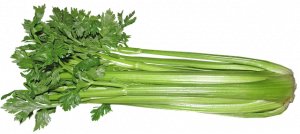- Celery is a classic of the salad bowl and absolutely essential for those crudities and scooping out dips. It is however a challenge for many gardeners. It’s just not that straightforward to grow but there are varieties out there which have made cultivation more accessible. Growing it does need some care though.
- The key, careful preparation and concern for its growing conditions that should ensure an excellent crop.
- The vegetable is also ideal for creating stocks and a base with onion for creamy risottos when finely cut up, and also makes for super-fun smoothies.
Celery is one of the vegetables that most gardeners would confidently say is their most difficult to grow properly. You have to be patient! It can take 8 months at least just to get good quality length in the stems and decent leafy heads. Some gardeners will harvest when its younger because they cannot wait. The plant seems to bolt all too readily as mine do from time to time when they’ve had their growth checked. leave too long and the stems become like a bit of wood and very stringy. If you get it right then joy! It’s possible to sow seed at various times to get a harvest for the summer months and even into autumn.
We’ve noticed that a number of new varieties are available that cannot be bought in the shops.
Soil Preparation
The challenge for any gardener is watering and that applies to other choice vegetables too like chard or beets. So choose a position in the garden where the soil is moisture retentive but never waterlogged. We always choose a fertile spot with a sunny position. If the soil is naturally dry or thin, bulk up with added loam, compost and manure. The best soil is probably that which had been manured about a couple of months beforehand and left to allow the rain to seep into it.
The ideal pH is about pH 6.5 to 6.8. Add lime to raise the pH by making it more alkaline.
The alternative is a raised bed and this option often suits better than open ground. At least growing conditions can be more easily manipulated to meet celery’s needs. A raised bed also helps where a covering is required at the end of season to protect the crop from early frosts and particular pests. A high cloche or net is perfect then.
Self-Blanching Versus Trenching Varieties Of Celery
Sounds a peculiar request but celery leaf stalks are best when they are blanched which means light has been restricted at these stems. We also see plenty of green stalk lettuce and it is popular with cooking especially – think risotto in particular!
To produce long white stems where there is no bitterness, means keeping light out. There are a few ways to do this.
You can choose trenching varieties which are not as popular as they used to be or self-blanching types. These latter varieties will blanch themselves when the plants are close together. Whilst they can produce green stems as opposed to white ones they are now bred for their sweetness and continue to be tender when grown in this close knit manner.
The trenching types require a trench to be dug and for young plants to be planted in it. They also need more space because room has to be left between rows so that soil is available for earthing up. The alternative is to grow them in blocks as in a raised bed and just cover the stems with stuff like toilet rolls, plastic drainage pipes, short pieces of guttering, damp proofing, cardboard even but anything to exclude light. More fancy covers include terracotta covers. The trenching types taste better than self-blanching varieties and are exceptional for salads and buffets Covering will always produce longer but more edible and sweeter stems.
Sowing Celery Seed
Celery seed is quite fine and needs to be sown indoors from March to April but can be extended to early May, at about 0.5cm deep in pots, seed trays and modules. Mix seeds with every fine sand to help with sowing.
A tray of good quality multi-compost or seed compost should suffice.
The tray is watered by misting with a spray bottle, allowed to drain and then placed in the greenhouse in a light and warm position. The temperature should be between 15 (60F) and 20°C. Celery seeds are usually slow to germinate but the rate is improved by applying a small amount of heat. We cover the pots or trays with a transparent plastic seed tray cover anyway just to retain moisture.
Do not exclude light as this helps enormously with germination. You can sprinkle lightly with vermiculite or sieved compost if drying out proves to be an issue.
Commercial celery seed, if you should ever get it from suppliers like Marshalls Seeds is heat treated to stop leaf spot disease.
The compost needs to be kept moist but not saturated and the seedlings usually appear in 14 to 21 days. Check the situation every day and mist as required. Once you see the majority of seedlings emerging the tray cover is removed and drop the heating down to 10°C (50F).
Keep watering but do not overdo this i.e. avoid waterlogging. Let the seedlings develop one true leaf before transplanting.

Handling Young Celery Seedlings And Plants
The young crops are best transplanted to individual cells in trays or larger trays, about 5cm apart and grown on to a point where they are large enough to be handled. As in all handling of young seedlings, grab the plant by the leaf and not the stem as this causes extreme damage otherwise.
The celery is grown on in cooler conditions but not cold. Cover with a cloche if a light frost is likely.
The young plants are hardened off by exposing to cold before planting out in May or June, allowing about 25cm between crops and 45cm between rows. I would let between 4 and 6 true leaves form before planting into their final positions. The soil must be watered regularly.
Planting In The Final Position
We talked earlier about manuring the patch but scatter pelleted chicken manure or Growmore at the suggested level onto the soil about a week before planting just rake in.
Most celery is grown in a trench which means it can be earthed up to produce whiter or redder stems are required. The trench needs to be 15cm wide and 10cm deep. Planting celery wider apart in the trench to 60-75cm (24 to 30in) makes it easier to place covers around the stem. The soil is retained from the trench so it can be earthed up as the stems grow.
Best to plant self-blanching celery in blocks with 25cm (10in) between plants each way.
In all cases the crowns of any young plants should not be buried too deeply, but at a soil level to avoid rotting. Firm lightly and water in well to make sure they all get off to a good start.
Growing In Pots
Celery is grown very successfully in large pots. It is the approach used by exhibitors because it produces the best and longest heads.
You would sow seed as before but instead of planting in the open ground pot up the plants until they can be grown in a 30 litre pot. Use good compost in all cases. Stake the plant so that it prevents collapse but also supports fully blanching material.
Watering is extremely important when doing pot culture because soil dries up far more quickly.
Caring For Your Plants
All the plants need a good soaking with water about once a week during any dry spells. Occasionally add liquid tomato feed which helps boost their growth. To reduce the amount of water loss from soil, mulch around the plant with well-rotted manure and compost.
When the plants are about 9in (23cm) tall then feed with ammonia sulphate at a rate of 50g per square metre (1½ per sq yd.) but do not let it touch the leaves. Do this fertiliser spreading before it rains or just water it all in.
For trenching celery, earthing or collaring starts when the plants are about 30cm high which is usually around August time. Even self-blanching types grown in blocks need collaring on the outer plants so that they remain white. Some gardeners place wooden boards around their celery blocks to maintain an absence of light.
Before earthing/collaring, some string is tied around the leaves and just above the stem but below the leaves. This process is repeated as the crop grows so that the stems remain tight together. The crop is harvested between September and December.

Bolting
An absolute pain which only occurs if the plants are too dry or its too cold. Just water as well as often and don’t plant out when its too early or in cold soil.
Harvesting
Self-blanching celery matures from August onwards and continues to crop until late summer when the trenching celery takes over. The latter type can be harvested up to the end of January if protected from the worst of the weather under cloches or grown in a polytunnel.
Water well the night before, lift with a fork and trim off the roots and any small leaves.
Store in a polythene food bag in the refrigerator for up to a week.
Pests
Slugs: These will eat any plant at all stages of growth and are a true menace. They hide in collars and within mulch. Protect plants by watering in a biological control. Pet-friendly slug pellets are available or use copper collars and barriers.

Celery Leaf Spot: No sprays are available for what is one of the most serious diseases of any crop. To avoid it buy heat treated seed if its available. Look too for varieties which are claiming to have some resistance to what is a major crop issue.
Celery Fly: The larvae of this fly burrow into leaves and produce blisters that turn brown. The best treatment is to pick off the affected leaves when you see them. Consider covering the crop with protective mesh if this is too much of an issue. We do nearly every other year.
Varieties Of Celery
If you are looking for seeds then here are a few varieties which should be of interest:-
cv. Blush has attractive pink-flushed stems that add colour and crunch to any salad. From Marshalls Seeds (UK).
cv. Celebrity is a self blanching type with short petioles which hold well. It has very little stringiness for a self-blanching type and is slightly quicker to mature than Victoria. Not often seen but well worth looking for although we could not find a seed supplier at this time.
cv. Giant Red. One for trenching. Has deep red stems that turn pink when blanched. Also one of the hardiest types so good for early winter cropping too. Find at Suttons or Kings Seeds.
cv. Lathom Self Blanching Galaxy. Crisp with a super flavour. Grown outdoors but increasingly popular for polytunnels and raised beds. Available from Thompson & Morgan (UK).
cv. Loretta. Award-winning self-blanching type that has long stalks. Used in porn films!? Seeds available from Marshalls and Suttons.
cv. Octavius F1. Produces strong, long, green stems with very good resistance to bolting. Ideal for drier areas of any country. Available from DT Brown.
cv. Victoria F1 is a UK-bred F1 Celery, that has been produced specifically for UK growing conditions. It has an attractive mid-green colour. It has a tall erect habit with fleshy petioles and is a self-blanching variety. Good for juicing. Available from Thompson & Morgan (UK).
Please note this page contains links to our affiliate marketing partner. Please read our affiliate disclaimer.
Seeds
Purchase your celery seeds here
Leave a Reply